人教版七年级英语上册Unit6教学设计
- 格式:docx
- 大小:10.22 KB
- 文档页数:4
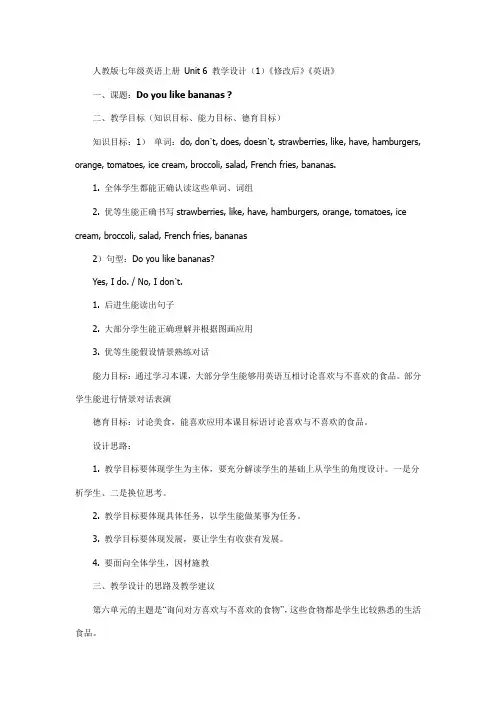
人教版七年级英语上册Unit 6 教学设计(1)《修改后》《英语》一、课题:Do you like bananas ?二、教学目标(知识目标、能力目标、德育目标)知识目标:1)单词:do, don’t, does, doesn’t, strawberries, like, have, hamburgers, orange, tomatoes, ice cream, broccoli, salad, French fries, bananas.1. 全体学生都能正确认读这些单词、词组2. 优等生能正确书写strawberries, like, have, hamburgers, orange, tomatoes, ice cream, broccoli, salad, French fries, bananas2)句型:Do you like bananas?Yes, I do. / No, I don’t.1. 后进生能读出句子2. 大部分学生能正确理解并根据图画应用3. 优等生能假设情景熟练对话能力目标:通过学习本课,大部分学生能够用英语互相讨论喜欢与不喜欢的食品。
部分学生能进行情景对话表演德育目标:讨论美食,能喜欢应用本课目标语讨论喜欢与不喜欢的食品。
设计思路:1. 教学目标要体现学生为主体,要充分解读学生的基础上从学生的角度设计。
一是分析学生、二是换位思考。
2. 教学目标要体现具体任务,以学生能做某事为任务。
3. 教学目标要体现发展,要让学生有收获有发展。
4. 要面向全体学生,因材施教三、教学设计的思路及教学建议第六单元的主题是“询问对方喜欢与不喜欢的食物”,这些食物都是学生比较熟悉的生活食品。
在教学时老师能够使用实物进行教学,增强学生的学习兴趣和学习效果。
在传授新知识时,为了为学生创设真实的,贴近生活的情境,可以设计一些游戏,即根据不同人对食物的不同喜好,自配营养餐和填写购物清单等,这样不但激发了学生学习的热情,也达到了练习重点句型的目的。
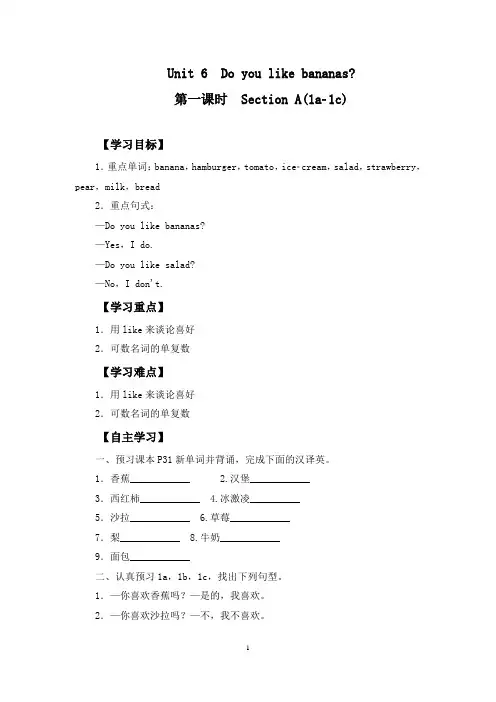
Unit 6 Do you like bananas?第一课时Section A(1a1c)【学习目标】1.重点单词:banana,hamburger,tomato,icecream,salad,strawberry,pear,milk,bread2.重点句式:—Do you like bananas?—Yes,I do.—Do you like salad?—No,I don't.【学习重点】1.用like来谈论喜好2.可数名词的单复数【学习难点】1.用like来谈论喜好2.可数名词的单复数【自主学习】一、预习课本P31新单词并背诵,完成下面的汉译英。
1.香蕉____________ 2.汉堡____________3.西红柿____________ 4.冰激凌__________5.沙拉____________ 6.草莓____________7.梨____________ 8.牛奶____________9.面包____________二、认真预习1a,1b,1c,找出下列句型。
1.—你喜欢香蕉吗?—是的,我喜欢。
2.—你喜欢沙拉吗?—不,我不喜欢。
【课堂导学】Step 1情景导入Teacher:There are many different kinds of fruits and vegetables in the world,and different people like different food.Everyone has its own taste.What kind of food do you like?What kind of food do you dislike?Today let's talk about the food we like and we dislike in Unit 6.环节说明:由学生感兴趣的话题导入新课,简洁明了,激起学生的学习兴趣。
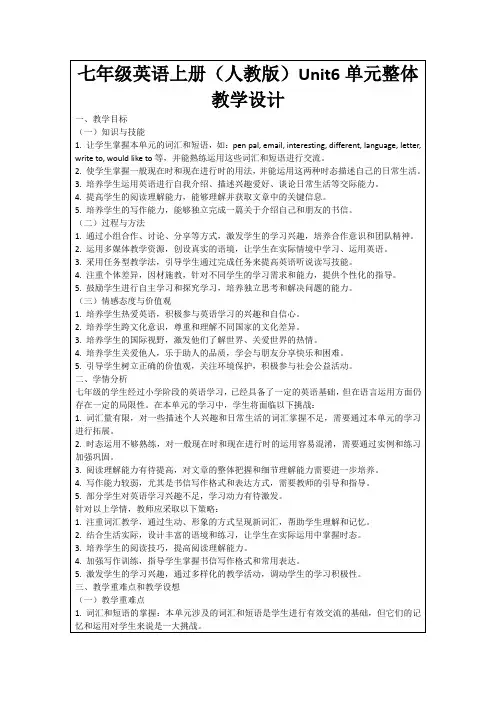
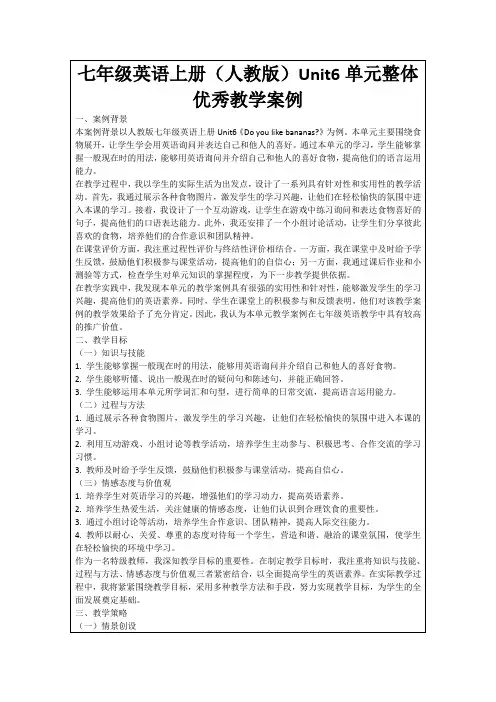
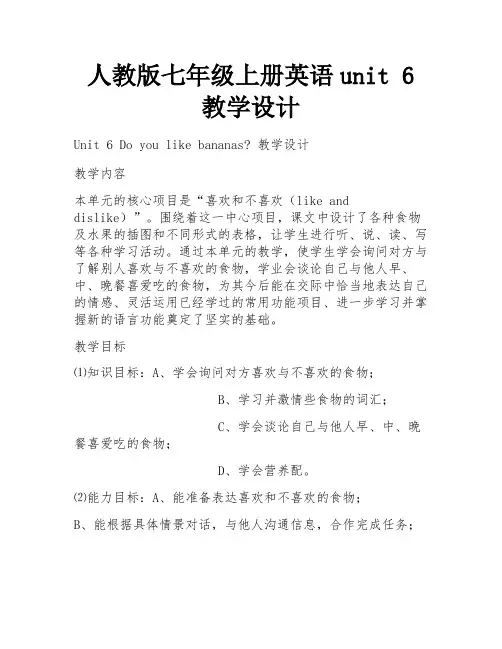
人教版七年级上册英语unit 6教学设计Unit 6 Do you like bananas? 教学设计教学内容本单元的核心项目是“喜欢和不喜欢(like and dislike)”。
围绕着这一中心项目,课文中设计了各种食物及水果的插图和不同形式的表格,让学生进行听、说、读、写等各种学习活动。
通过本单元的教学,使学生学会询问对方与了解别人喜欢与不喜欢的食物,学业会谈论自己与他人早、中、晚餐喜爱吃的食物,为其今后能在交际中恰当地表达自己的情感、灵活运用已经学过的常用功能项目、进一步学习并掌握新的语言功能奠定了坚实的基础。
教学目标⑴知识目标:A、学会询问对方喜欢与不喜欢的食物;B、学习并激情些食物的词汇;C、学会谈论自己与他人早、中、晚餐喜爱吃的食物;D、学会营养配。
⑵能力目标:A、能准备表达喜欢和不喜欢的食物;B、能根据具体情景对话,与他人沟通信息,合作完成任务;C、通过听、说、读、写四项技能的训练,促进学生语言运用能力的提高。
⑶情感目标:A、通过学习西文食品文化,促使学生了解西方生活方式与文化,培养跨文化交际的意识;B、通过开展小组活动,指导学生积极与他人合作,培养他们的合作精神;C、通过任务型活动,使学生学会在实际生活中均衡饮食,合理配餐。
教学重点、难点重点:A动词like一般现在时的各种句式及一般疑问句的肯定、否定回答;B关于各种食物的词汇;C名词复数的使用。
难点:一般现在时中单数第三人称的变化形式。
课时安排第一课时Section A la –lc第二课时 Section A 2a –4第三课时Section B la –2c第四课时 Section B3a –4Self-checkPe riod One课前准备教师:搜集关于食物的图片,多媒体教学课件,制作表格(见教学步骤)。
教学设计Step One: New words.①Present the new words.T:Let’s play a aguessing game. Is it an apple in my bag?Touch andtell me the answer.S1: (Touch and say)Yes, it’s an orange.T:I like oranges. Like means”喜欢”. Read afterme .L-I-K-E,like.Ss: L-I-K-E,like.T:Do you like oranges?S2:Yes,I do.T: Do you like oranges?S3:No, I don’t.(Teacher writes the title on the blackboard.)T: Now today I have a lot of delicious food. First let’t look atsome fruit. Look!(Show a picture of a banana.)T:What’s this in English?It’s a banana. Read afterme,B-A-N-A-N-A,banana.Ss:B-A-N-A-N-A,banana.T:Whtat color is it?Ss:It’s yellow.(Then look at some pictures and teach the other fruitwords in the same way such as strawberry,apple.)(Next go on learning the vegetables and the other food in the smeway with the pictures.)T:Look at the pictures and fill in the chat according to thecategory.Step TwGrammar.①Present the countable nouns and the uncountable nouns.T:Look!What are these? (Show a picture.)S1:They are oranges.T:How many oranges are there?Let’s count. One,two.S1:Two.T:And what are these? (Show another picture.)S2:They are apples.T:How many apples are there? Let’s count them.One,two,three.S2:Three.T:What’s this?S3:It’s broccoli.T:Can we count it”Can we say a broccoli?S3:Sorry, I don’t know.T:We can’t say a broccoli because it is the uncountable noun.Nouns contain the countable nouns and the uncountable nouns. Countable nounscan be counted with number ,and we add –s or –es to make the blural. Forexample,we can say an apple, two apples,three eggs. Uncountable nouns can’t becounted with number,andthey don’t have plurals. For example, we can say salad,broccoli,but we can’t say salads,broccolis.T:Look at the pictures. Fill in the chart.(Show some pictures offruits and vegetables.)Countble nouns Uncountable nounsT:Check the answers.②Present the rules of noun plural forms.T:look at the pictures,can you say them?S:Yes,three tomatoes,two oranges, three strawberries.T:Look at the three rules of plural forms. Are theythe same?S:Of course not.Step Three: Drills.①Present the new drills “Do you like…? Yes,I do/ No, I don’t.”T:Oh,we have lots of delicious fruit. I like apples best.(Holding apples)Do you like them?S1:Yes, I do.S2:No, I don’t. I like salad.T:Do you like salad?S3:Yes, I do./No, I don’t.(Ask some more students to practice like this.)②Practice the drill.T:Work in pairs.Ask and answer with your pictures.(Before class the students have drawn some pictures of the food.)Sa:Do you li ke…?Sb: …(Then ask more pairs to practice.)T:Let’s open your books and do 1b.Listen and number1-3.(The students listen and then check the answers.)Step Four: Task.T:Let’s make a survey.You can ask eight friends what they like anddislike. Then fill in the chart.Tom Kate Li Lei …ApplesBananas…(Then ask some students to report.)S1:Five of the students like…, two of them like…S2:…Step Five :Summary.In this class,we’ve learnt the names of foods, fruitand vegetables and practiced asking and answering questions about likes and dislikes.Please remember the rules of noun plurals.Homework.Make a survey about your parent’s likes and dislikes using Do youlike…?Unit 6 Do you like bananas?Period Two课前准备教师:搜集关于食物的图片,制作表格(见教学步骤)。

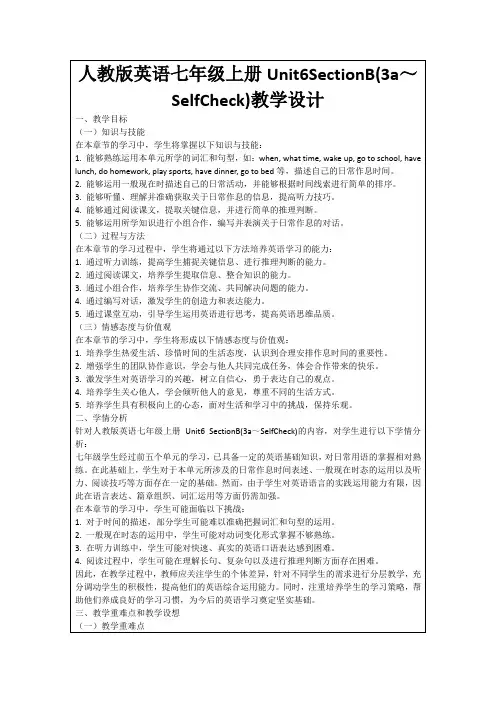
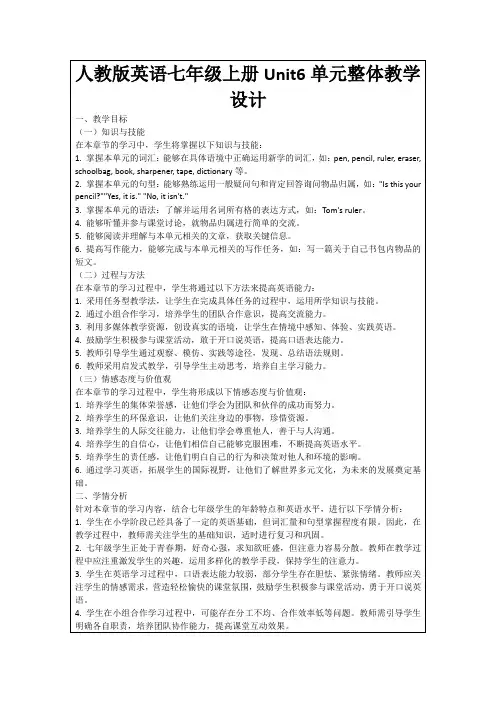
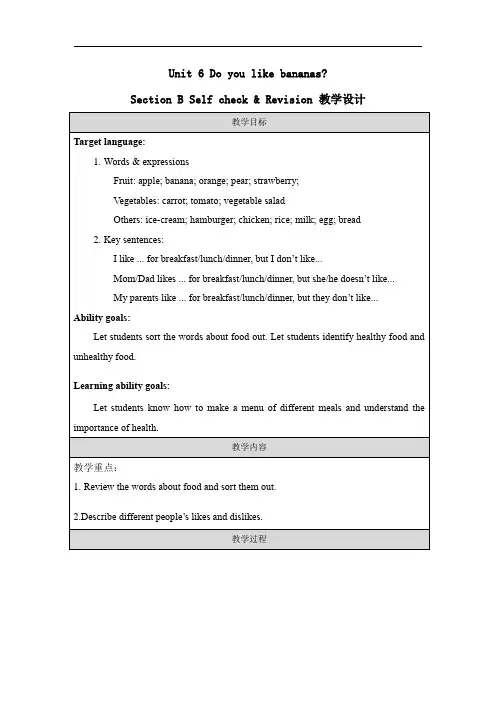
Unit 6 Do you like bananas? Section B Self check & Revision 教学设计Step 1: Warm-upThis week, there will be a Family Day and you need to make a menu of your family’s three meals. What should you do first? Go to find the food in your fridge. Let’s see.Step 2: Revision of vocabulary1.In the fridge, first you can find some fruit. So what fruit can you find? This is astrawberry. This is an apple. This a pear. This is a banana. And this is an orange.2. Then we can find some vegetables. Let’s see what are they? First, this a tomatoand this is a carrot. How about this? It’s vegetable salad.3. Except fruit and vegetables, you can find some other food. For example, there issome ice-cream, a hamburger, chicken, rice, milk, bread and an egg.4. You can see so many kinds of food in the fridge, so if you want to make the menufor your family’s 3 meals, what is very important? Health. Are the foods in the fridge healthy? Put H next to healthy food and U next to unhealthy food.5. So if you want to be healthy, what should we do?You must eat well. It meansyou eat healthy food. And then you have good eating habits.Step 3: Rules of plurals.We’ve learned so many words about food. Some are countable while some are uncountable. For countable nouns, the plural form is also important.1.Self-check 1: Write the plurals of the words in the correct column>2.3.Can you think about more examples about the last 2 groups?+es: potatoes, boxes, watches; y→i+es: libraries4.Now let’s see the rules of plurals.Step 4: Talking about likes and dislikes1.After choosing the healthy food, you need to choose what you and your parents like. We can’t make a menu with food that people dislike.2.Self check 2: Choose the food you like for three meals. Write down 3 sentences.E.g. I like ... for breakfast, but I don’t like...I like ... for lunch, but I don’t like ...I like ... for dinner, but I don’t like.3.Self check 3: How about your parents? Write down 5 sentences about your parents’ likes and dislikes. You can use the following sentence patterns.E.g. Mom/Dad likes... for breakfast/lunch/dinner, but he/she doesn’t like...My parents like ... for breakfast/lunch/dinner, but they don’t like...Homework1.Finish the exercises.2.Make a menu for your Family Day.。

Unit 6Do you like bananas?第一课时Section A(1a-1c)1.重点单词:banana,hamburger,tomato,icecream,salad,strawberry,pear,milk,bread2.重点句式:—Do you like bananas?—Yes,I do.—Do you like salad?—No,I don't.1.用like来谈论喜好2.可数名词的单复数1.用like来谈论喜好2.可数名词的单复数一、预习课本P31新单词并背诵,完成下面的汉译英。
1.香蕉____________ 2.汉堡____________3.西红柿____________ 4.冰激凌__________5.沙拉____________ 6.草莓____________7.梨____________ 8.牛奶____________9.面包____________二、认真预习1a,1b,1c,找出下列句型。
1.—你喜欢香蕉吗?—是的,我喜欢。
________________________________________________________________________ 2.—你喜欢沙拉吗?—不,我不喜欢。
________________________________________________________________________Step 1情景导入Teacher:There are many different kinds of fruits and vegetables in the world,and different people like different food.Everyone has its own taste.What kind of food do you like?What kind of food do you dislike?Today let's talk about the food we like and we dislike in Unit 6.环节说明:由学生感兴趣的话题导入新课,简洁明了,激起学生的学习兴趣。
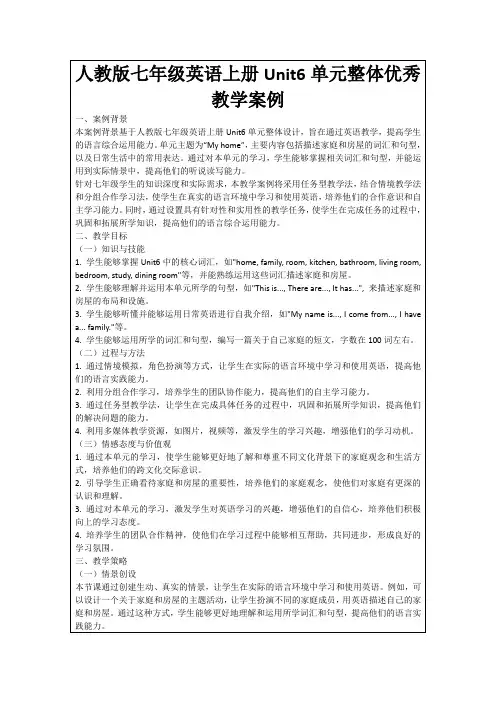
新人教版七年级上册英语教课设计Unit.6 Unit 6 Do you like bananas?授班授型教课目教课内容要点点学情剖析授日期新授学数The 1st period (Section A 1a — 1c)1.Learn to talk about likes and dislikes2.Learn food names3.Learn to concerned with others, formed a close friendship with others.1 New words: like, banana, hamburger, tomato, broccoli, French fries, orange, ice, cream,salad, strawberry, pear, have,2Sentence Patterns:— Do you like salad?— No, I don ’t./ Yes, I do.— Does he like pears?— Yes, he does./ No, he doesn’t.He/ She likes ⋯ .He/She doesn’tlike ⋯ .— Do you like salad?— No, I don ’t./ Yes, I do.— Does he like pears?— Yes, he does./ No, he doesn’t.He/ She likes ⋯ .He/She doesn’tlike ⋯ .教课方法学方法引入任型教课、分价法、直教课法、模拟示范法、情形教课和合作学法前、堂内外、听写合教课程注I. Warming-up and revision1 Say something about the answers to the English Papers and the Exercises.Ask the Ss to pay attention to what mistakes they have made.2 Ask some of them to read 3a on page 29 from memory.3. T: What ’ s this? ( It’ s al.soccer) balCan you use this word make sentences?Ss: Do you have a soccer ball?I have a soccer ball.Let ’ s play soccer.教课步及主要内容堂⋯I like playing socce r. I don’ t like playing soccer.II. PresentationStep 1.T:Are you free this Sunday?Ss: Yes.T: Well, let’ s go to KFC.Ss: That sounds interesting/fun⋯T: In KFC, there are much food (Show pictures of food) , what do you like?Ss: I like⋯Step 2.T: What’ s this?S: It’ s a hamburger.T: What are they?S: They ’hamburgersre.T: Do you like hamburgers?S: Yes./ No, I don’ t like(Tell Ss the short answer: Yes, I do. /No, I don’ t. )ing the same way to teach other words.Show the followings on the Bb.1.Learning the new words: Food of the section by showing slides.2. Read and try to remember them within 15 minutes.3. Talk about the Ss rite’ foodfavo.4.The use of countable and uncountable nouns.5.Do Part 2cIII. ChattingT: In KFC, I like apple pie. It’ s very delicious. Do you like apple pie? (Yes./ No) There are many pies, which pies do you like?(banana pie, strawberrypie, orange pie)T: What’ s this?S: It’ s a /an⋯.(banana, orange, strawberry)T: What are they?S: They ’ re⋯. (bananas,anges,or strawberries)IV. Healthy foodT:Apple, banana ⋯these fruit can make us keep healthy. Vegetables also canmake us healthy. So I like broccoli. Broccoli is uncountable.T:Do you known tomato is a fruit or vegetable.(Vegetable)Write them on BbV. Practice1. T: Do y ou like⋯( broccoliomatoes),Yes, I do. / No, I don’ t.2.1a Ask one student to read the words Matchthe words with the things in the picture.3.1b Listen to the tape.4 1c Pairwork(do as 1b)5 2a Ask one student to read the words. Circle the food you hear. 2b Listen again. Fill with the blank. Then read the conversation. VI. PairworkMake a conversation as Part 2bAsk the Ss to act.Unit 6 Do you like bananas?授班授型教课目教课内容要点点学情剖析授日期学数The 2nd period (Section B1a –1c)1Teach the words: food . Get the students to use them freely.2 Get the students to learn to filling the information box.New words:food, egg, apple, carrot, chicken, breakfast, lunch, dinner, fruit,Sentence Patterns or phrases:Do you like⋯? Yes, I do./ No, I don’ t.Do they like⋯? Yes, I do./ No, I don’ t.Does he / she like⋯? Yes, he/she does. / No, he/she doesn’ t. They like⋯They don’ t like⋯He/she likes⋯He/She doesn’ t like⋯Do you like⋯? Yes, I do./ No, I don’ t.Do they like⋯? Yes, I do./ No, I don’ t.Does he / she like⋯? Yes, he/she does. / No, he/she doesn’ t.They like⋯They don’ t like⋯He/she likes⋯He/She doesn’ t like⋯教课方法学方法引入任型教课、分价法、直教课法、模拟示范法、情形教课和合作学法前、堂内外、听写合教课程注I. Revision1.Greetings.2.Enjoy “ the apple ” song. T: Doyou like this song?Ss: Yes, we do.T: Do you like apples?S1: Yes, I do.T: Do you like⋯?教课步及主要内容堂堂小S2:⋯⋯T:If I go to your home, what fruit will you show me?( Help to say. )Ss: Do you like pears/peaches/ grapes/bananas/⋯?T: Yes, I do. / No, I don .’tT: Can you write down my favorite fruit?The Ss write them down. And see who write the faster and the best.II. PresentationT: Does you like⋯? S1: Yes, I do. / No, I don’ t.T: Does S1 like⋯? S2: Yes, she/he like⋯No, she/he doesn’ t like⋯Then ask the Ss to practice in group.III . Task 1.Food SurveyDo you like tomatoes, Li Lei? Yes, I do. / No, I don’ t.Name Like DislikeLi Lei tomatoes hamburgersThen report like this: Li Lei likes to matoes, but he doesn’ t like hamburgers⋯IV. Task 2.Show the pictures of the animals.T: What ’ s the favorite food?Ss: Cabbages/ bananas/ meat(chicken)/ fish⋯V. PresentationT:Li Lei likes tomatoes. But do you know what he likes for breakfast/lunch/ dinner ⋯?(Teach the new words: breakfast, lunch, dinner)Ss:⋯T: What about you? What do you like for breakfast/ lunch/ dinner?Ss: I like⋯for⋯VI. Task 3. Guessing gameShow the picture of Dave/ Helen/⋯Then Ss do like this, S1: Does Dave like apples for breakfast?S2: Yes, he does./ No, he doesn’ t.VII. Pairwork(Do Part 3,4) Section B 1b,2a,2b,2c小与作VIII. HomeworkMake a survey.( The birthday presents for your parents )What should you give your parents for their birthdays? What ’ s the best gift you have ever received? Please make up a shopping list you could use to buy本作birthday presents for your parents.Preparation:a. know about the parents’ birthdayb. know about their like and dislike food, then fill in the form授班授型教课目教课内容要点点学情剖析教课方法学方法引入教课步及主要内容本教课后(堂理念,教课成效及改想)Unit 6 Do you like bananas?授日期稳固学数The 3rd period (Section B 1a –1c)Learn to read and write an article about sb likes to eat for breakfast, lunch, dinner,and dessert.New words:run, runner, eat, star, lot, lots of, healthy, food, dessert, listrun, runner, eat, star, lot, lots of, healthy, food, dessert, list任型教课、分价法、直教课法、模拟示范法、情形教课和合作学法前、堂内外、听写合教课程注I. Revisiona. Greetingb. Free talkII. Presentationa. Show the pictures of Liu Xiang / Xing Huina / Louis /⋯.T: Do you know them? Who’ s this/ that?What are they? ( Help to say )Ss: They are running star. Liu Xiang and Xing Huina are the winners in theOlympic Games.T:Do you like them? What do they have for breakfast/ lunch/ dinner?Ss: ⋯b.Show another picture of Sandra Clark.T: What does she like for breakfast/ lunch/ dinner? Please read the text ofP35 3a quickly and find the answers.Name breakfast lunch dinner堂堂小Sandra ClarkAsk several Ss to retell the text.Tell Ss: One should eat well in breakfast, eat enough in lunch, eat less in supper.III.Writing ( 3b )Show the picture.T: What can you see in the picture? Who’ s he? What does he like to eat for breakfast/ lunch/ dinner? Please read and fill in the blank. Then check theanswers.IV . Teaching“ lots of, healthy”.a. Liu Xiang is a running star ,Xing Huina is a running star, too.In China we have a lot of running stars like them.We also have lots of other stars like film stars, TV stars, singing stars,sport stars ⋯b. Show a picture of a strong man.T:Does he look fine? Does he look healthy?c. Show the pictures of Mr Fat and Mr ThinT:Whom do you like better, why?V. TaskTask 1. Discussion: What can make you healthy?( Running, Playing sports, Eat fruit ⋯ ) Task 2. Thisweek we have learned lots of food. Some of themare healthy food, but some of them are unhealthy food. Please fill in the form.Healthy UnhealthyVI. GroupworkT: Look, the sun in shining brightly, the weather is neither too hot nor too cold.It ’ s cool. It’ s a good time for us to have a picnic. Do you want to have a picnic? What do you like/ have for the picnic?Ss: I like⋯T: Ah, so much food. OK, let’ s go. shoppingButbefore we goshopping, we should make a list, a shopping list. Now,four Ss a group to discuss, then write the shopping list.(4a)Ask the Ss report their list.小与作VII. Homework本作If you want to be healthier, which food do you think is the best for breakfast/ lunch/ dinner?本教课后(堂理念,教课成效及改想)Unit 6 Do you like bananas?讲课班级讲课种类教课目的教课内容要点难点学情剖析讲课日期复习课学时数4th period (Self –check)1.Learn to talk about likes and dislikes2.Learn food names3.Learn to concerned with others, formed a close friendship with others.1.Revise the food names. ( singular and plural )2.Revise how to inquire sb s or’dislilikes.3.Revise how to write an article which is about sb’ s likes for three meals1.Revise the food names. ( singular and plural )2.Revise how to inquire sb s or’dislilikes.3.Revise how to write an article which is about sb’ s likes for three meals教课方法学习方法课题引入教课步骤及主要内容任务型教课、分级评论法、直观教课法、模拟示范法、情形教课和合作学习法课前预习、讲堂内外练习、听闻读写联合教课过程设计备注I. Revise1.Revise the food names. ( singular and plural )2.Revise how to inquire sb s or’dislilikes.3.Revise how to write an article which is about sb ’ s likes for three meals .II. Go through self-check1.Vocabulary Revision: Check the words you know.2.Write down some new words in your notebook.3.Draw the food you like to eat for lunch.4.Ask your classmates what they like to eat for lunch. Find someone wholikes to eat the same lunch as you.讲堂练习III. Have a quiz.小结与作业讲堂小结IV . Homework本课作业 1. Finish the workbook.2.Do the exercise on the newspaper.本课教课后记(讲堂设计理念,实质教课成效及改良假想)。
Unit 6 A Day in the LifePeriod 5 Section B (Project)一、教材分析What: 本单元的项目活动主要让学生通过采访了解不同职业从业者一天的作息。
Why:学生在报告中需要灵活运用一般现在时动词第三人称单数形式的用法。
此处的项目活动不仅有助于学生巩固本单元所学,提升自己的书面和口语表达能力,更重要的是能够提升学生对单元主题的认识,引导他们将视野从学校生活转向更广阔的社会生活,从不同职业人员的作息时间了解他们的社会生活节奏以及需要面临的挑战,以增进学生对社会的了解,并能对不同职业人员繁忙的生活节奏表示理解和尊重。
How:活动3a提供了几个职业作为参考,活动3b则列出一些问题供学生在采访时使用。
活动3c 要求学生将采访中所获得的信息整理成报告,然后向全班汇报。
二、教学内容1. 能够通过采访、了解并记录被采访者的日常作息。
2. 能够运用本单元所学的时间表达法介绍被采访者的日常生活。
三、教学目标1. 能够从他人的生活日常中发现有利于时间管理和身心健康的想法和做法,并从中受到启发和教育。
2. 能够理解不同职业从业者的工作特点和不同作息,并能尊重他们的生活方式。
3.认识到不同人的日常生活可能受到文化、地域、家庭背景等多种因素的影响,从而更加理解和尊重文化的多样性。
四、教学重难点重点:在与他人谈论日常活动时,学生能够专注于重点活动和时间安排。
难点:学生能够以一种结构化的方式和一定的逻辑顺序组织语言,使整个内容连贯易懂。
五、教学准备PPT,多媒体等六、教学过程Step 1 Lead inIn class, ask students about their parents or other loved ones, learn about their occupation and their daily routine.Step 2 Work on 3a1.Ask students to choose a profession that they want to know more about.2.Choose two or three students to come to the front of the classroom and share their ideas.Step 3 Work on 3b1.Ask students to ask a person who works in that profession questions to find out his or her workday routine. Then complete the table in 3b.2.Ask students to try to make complete sentences using the third person singular form of verbs based on the timetable.Step 4 Work on 3c1.Ask students to organize their language and give a report on their interview.2.Ask students to pick one of the reports they are interested in and vote. The one that gets the most votes wins.【设计意图】通过在班级进行汇报,学生能够充分练习本单元的目标语言和语法。
人教版七年级英语上册Unit 6 教学设计( 1 )
一、课题:Do you like bananas ?
二、教学目标(知识目标、能力目标、德育目标)
知识目标:掌握询问对方喜欢与不喜欢食物的几种典型的句型;学习常见食物的名称。
能力目标:通过对食物名称和询问句型的学习,学会谈论自己与他人早、中、晚餐喜爱吃的食物。
通过对食物的学习了解,学会配制营养餐。
德育目标:通过对不同食物的学习,让学生了解哪些是有益于健康的食品,哪些是不益于健康的食品,从而使学生学会均衡饮食,不偏食。
通过对食物喜好的提问,能增强同学之间的相互了解和友谊。
三、教学设计的思路及教学建议
第六单元的主题是“询问对方喜欢与不喜欢的食物”,这些食物都是学生比较熟悉的生活食品。
在教学时老师能够使用实物进行教学,增强学生的学习兴趣和学习效果。
在传授新知识时,为了为学生创设真实的,贴近生活的情境,可以设计一些游戏,即根据不同人对食物的不同喜好,自配营养餐和填写购物清单等,这样不但激发了学生学习的热情,也达到了练习重点句型的目的。
四、教学向导
语言功能
语言目标
语言结构
谈论喜欢与不喜欢的食物
* 动词like 的用法
* 一般疑问句的肯定、否定回答
* 名词复数的使用
动词like 的肯定、否定句的用法
* 动词like 的一般疑问句的肯定、否定回答
重点词汇
学习策略与思维技巧
跨学科学习
hamburgers, tomatoes, broccoli, French fries, oranges, ice cream, carrots, apples, chicken, breakfast, lunch, dinner, fruit, vegetable.
* 培养学生对同一事物要有不同的看法。
* 培养学生对所学知识进行分类的能力。
* 艺术:画画
* 数学:数数
* 社会实践:制作购物单;制作调查表。
五、教学重点及难点
1.教学重点:词汇:有关食物名称的单词。
句型:Do you like …? Yes, I do. / No, I don ' t.
2 .教学难点:创设语言交际情景,操练句型。
六、具体教案设计
Unit 6 Do you like bananas ?
课时安排:四课时
第一课时:P31—P32 第二课时:P33—P34 第三课时:P35 第四课时:
P36 第一课时:P31—P32
Step 1 讲授1A 中的新单词
1.通过用“ What ' s this in English ? ” 句型询问一些具体的食物或图片,如:apple, orange, meat, rice 等,让学生通过直观回忆以前所学过的食物名称。
2.呈现新的食物或食物幻灯片,激发学生的求知欲,从而引出本课的新单词。
3.朗读P31—1a 中的新单词。
(先全班,再小组,然后到个人,层层检查、补漏。
)4.将学生分成两大组,以竞赛的方式让各组派一名学生,将食物的单词贴到挂图相对应的食物上,看哪组贴得最多,最准。
Step 2 Presentation
1.通过吃的动作和高兴的表情来展现“ like ”一词的意思,并将“like ”板书在黑板上;通过摇头的动作和皱眉的表情展现“don't like ”一词的含义,并将“don't
like ”板书在黑板上。
2 .通过动作及表情引出I like bananas, I don ' t like broccoli. 然后过渡到Do you like bananas / broccoli ? Yes, I do. / No, I don ' t.
3.选择不同的食物,向学生提问:Do you like…?让学生根据自己的实际情况回
答:Yes, I do. / No, I don ' t.
Step 3 Listening
1.看P31—1b 的对话,听录音,完成书上要求标号的任务。
订正答案。
2 .跟读对话,以小组为单位朗读对话。
3.进行小组对话练习,可以更改有关的食物名词,编出自己的对话。
Step 4 Listening
1.大声朗读P32—2a 中的单词,让学生先认真听,然后模仿重复两遍。
2.让学生听一遍录音,了解大意,抓住关键词。
3.让学生第二次听录音,在表格中圈出所听到的单词。
订正答案。
4.P32 —2b 听录音,要求学生将听到的单词填入横线上。
订正答案。
5.再听录音,跟读1—2 遍,分角色进行对话。
Step 5 Practice
让学生两人一组进行对话操练:Do you like…? Yes, I do. / No, I don
t. 通过句型的操练,增进学生之间的相互了解。
Step 6 Homework
Step 7 教学后记。